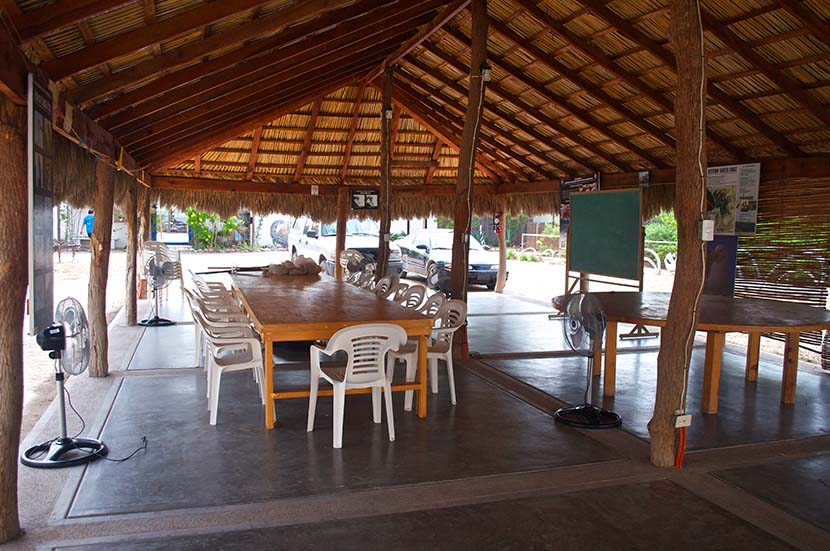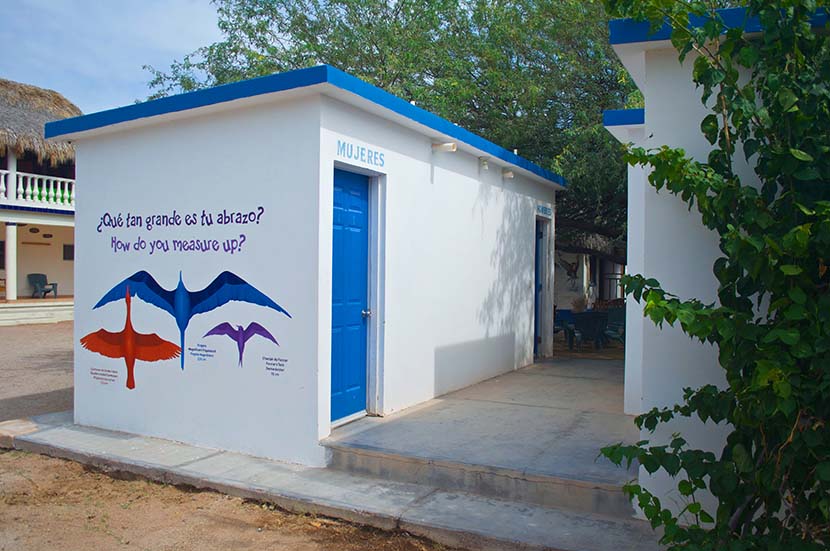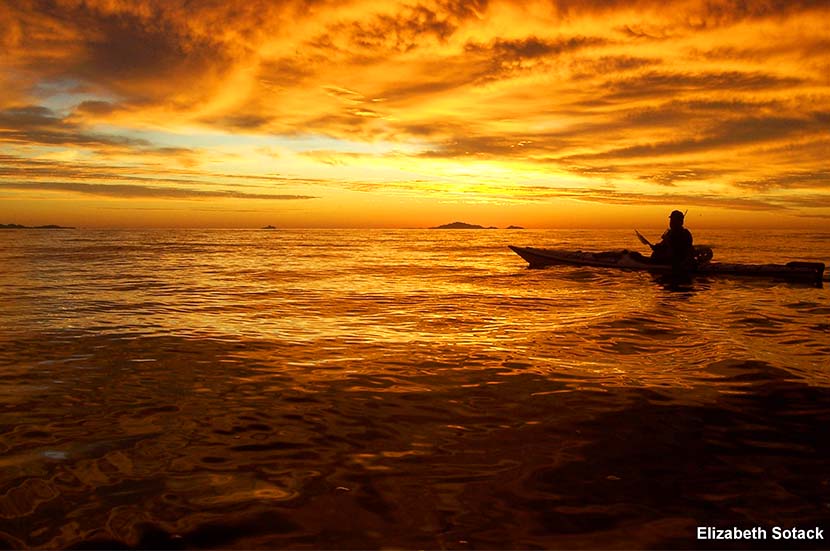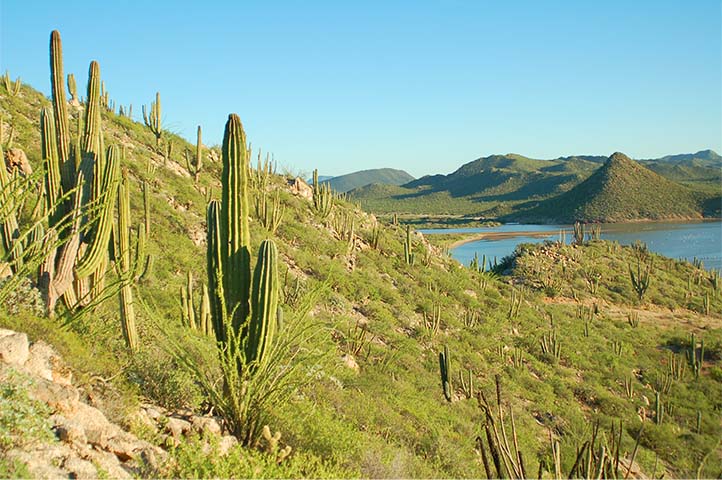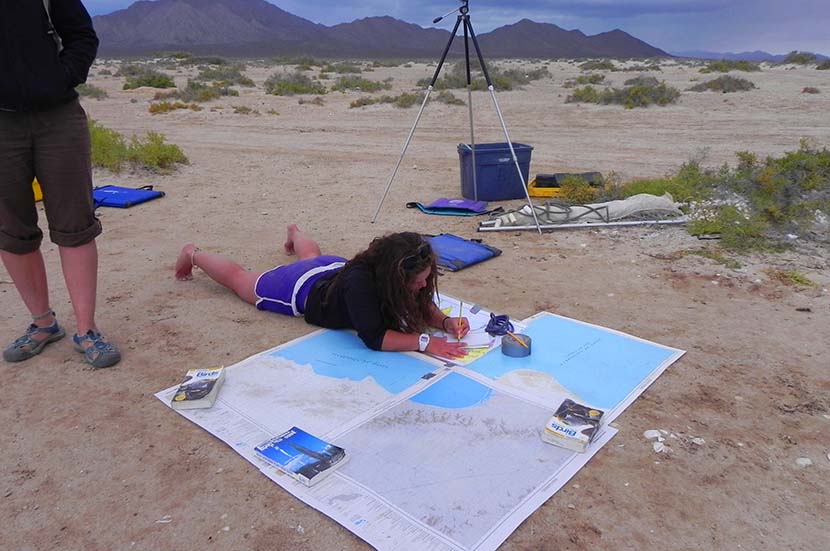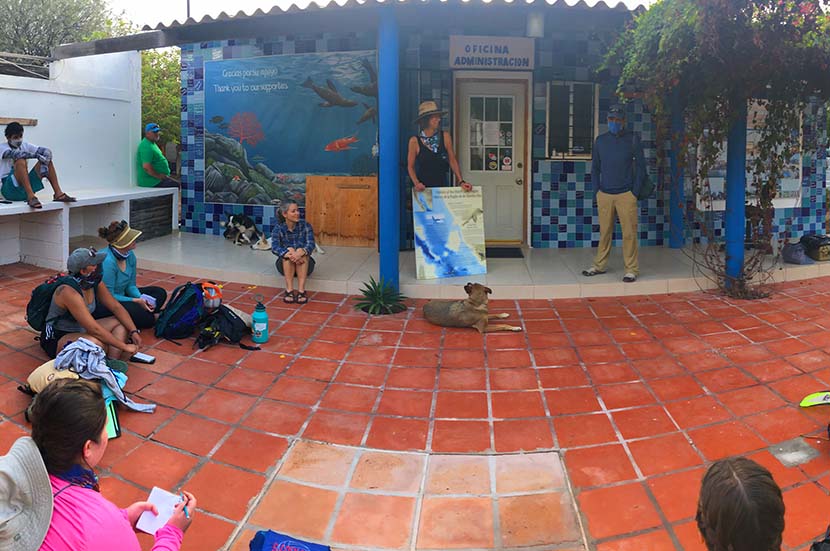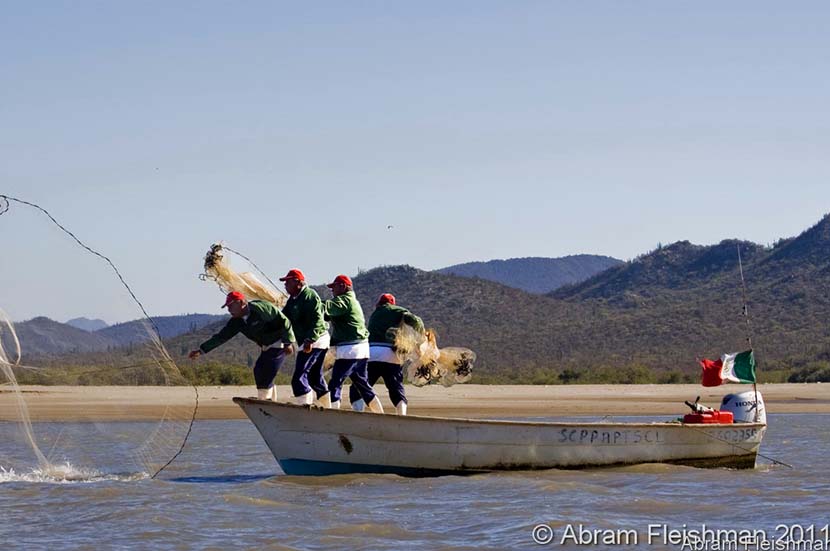Visitor Information
Visitor Information
Prescott College’s binational field station dedicated to biocultural conservation through education, community, science and knowledge exchange.
Welcome to the Kino Bay Center
The Kino Bay Center hosts many different types of visitors from academic, government, and research institutions and community groups from Mexico, the United States and around the world. The center supports individual researchers, school groups, university classes, workshops, meetings and conferences. As long as your purpose is aligned with the mission and objectives of the Center, and we have room, we will be happy to host your group.
A fully-equipped living-learning center on the shores of the Gulf of California
The Kino Bay Center sits on a one-acre site close to the main boulevard along the beach of New Kino (10 kilometers from Old Kino). The Center is best suited to host small resident groups (10 – 20 people). Larger groups using the Center for conferences or meetings are encouraged to secure off-site housing. The facilities include
Living space for 45 students, faculty, and visiting researchers comprised of:
- Camping space under two large 2nd story palapas (ocean view) – each visitor is provided with a cot, bug net and storage space
- Two shared bathhouses (9 total toilets and showers)
- Fully equipped group kitchens (2)
- Visiting researcher apartment
- Faculty house
- Manager house
- Staff house and casitas
- Library and computer lab
- Classrooms (equipped with smart TV or projector, white boards and black boards
- Large palapa (covered space) for meetings
- Other assorted meeting areas
- Faculty and researcher work space
- Laundry facilities
- Various lab and field equipment
- 3 Boats with outboard motors, radio, and safety gear (30 person capacity total)
- Snorkeling gear and wetsuits
- Wireless internet access
- Center operations workshop
Kino Bay has a coastal desert climate, with low rainfall (~16cm/year). Winters tend to be sunny, cool, and windy, while summers are very hot and humid in the coastal region. Day and nighttime temperatures can vary enormously (up to 50 degrees F).
During October, the weather is usually quite warm, water temps are in the low 80’s, and there may be mosquitoes. Tropical storms and calm seas are both possible during these months. Late fall is mild with warm days and pleasant nights as seawater temperatures fall and windy days become more common. December, January, and February can be quite cool, with occasional rain, cool windy days and cold nights. Sea water temperatures drop to the low 60’s or 50’s and windy conditions can upset boating schedules. Spring months of March and April are usually periods of unpredictable weather with warm spells, windy periods and cold water. May and June are warm and calm months with hot days and warm but comfortable nights; the water temperature is in the 70’s. The summer months of July – September are generally very hot, and humid with possibilities of tropical storms and bugs.
View current data from the Center’s weather station here:
https://ambientweather.net/dashboard/40f30486704b70d83dd5d916e095549a
Be prepared with layered clothing, and sun protection. This part of the Sonoran desert experiences weather extremes. Heat, dehydration, sun exposure, wind, cold and varying water temperatures are all important factors. The Center has a limited selection of snorkeling gear for visitor use. If you plan to do a lot of snorkeling, you may want to bring your own equipment.
The climate in Kino can be highly variable. Unless you are visiting in the height of summer, be prepared for warm to hot days and cool to very cold nights (Temps can drop close to freezing in the midwinter).Visitors who will be camping under the large palapas will be provided with a cot and bug net but must bring their own bedding. A sheet, pillow, and sleeping bag are very useful. Visitors also must bring their own towels and toiletry items. Visitors renting rooms will be provided bedding.
Kitchens are well equipped and visitors may bring their own food from the states, buy food in Hermosillo or Kino, or eat out at restaurants. While most groups prepare their own meals, the Center can provide meals for an extra fee.
Directions and Tips for Driving Prescott College or Private Vehicles to the Kino Bay Center
The Kino Bay Center is ideally located to explore the rich cultures and ecology of the region. Mangrove estuaries, sandy beaches, offshore islands, rocky intertidal areas, mudflats, and diverse desert habitats are all within an hour’s drive or boat travel time. The Kino Bay Center is located in New Kino, approximately six miles from the center of the main town of Bahia de Kino (Old Kino) and half an hour from the Comcaac village of Punta Chueca. There is a small convenience store on the corner near the Center and Old Kino has many small grocery stores, general stores and restaurants.
Kino Bay is a 90 minute drive from the Sonoran state capital, Hermosillo, a large city with an international airport, excellent health care facilities, and a complete array of stores and services. Buses, cabs or rental cars are available from Hermosillo to Kino at reasonable rates. Kino is an approximately five hour drive from the US/Mexico border crossing at Nogales.
If you are planning to drive from the US, please plan on crossing the border at the Mariposa “Truck Crossing” west of the main Nogales crossing. The crossing typically operates from 8am -10pm seven days a week. (The downtown crossing is open 24/7). Please note that the highway from Nogales to Hermosillo is a toll road (3 separate tolls) US dollars are not accepted, be prepared to pay in pesos (Approximately 200 pesos per car from Nogales to Hermosillo).
In general the roads are good, although roads are maintained to a lesser standard than in the United States- be alert for things like unexpected speed bumps, cars/trucks with dim/missing lights, animals/people on the roadway. Driving at night should be avoided. Occasionally you will be stopped at checkpoints by armed military or drug enforcement police. All police WILL be in uniform and in groups on the main highway. Treat them respectfully and answer questions honestly.
The Center’s address is:
Prescott College – Kino Bay Center
151 Calle Cádiz
Bahía de Kino, Sonora, México, 83340
Before you leave, as you are making your plans, or if you have any questions or problems, please contact the Center’s Visiting Groups Coordinator.
If you are going to arrive late in Kino, please call.
IN AN EMERGENCY
If you can get to a phone and you are in Mexico, call the Visiting Groups Coordinator.
A NOTE ON BORDER REGION SECURITY
Reports of violence in recent years and months have increased in the border region. Nogales has experienced some incidences of violence, almost all of which are away from ports of entry and targeted toward drug – related groups. We recommend that you do not cross through the downtown Nogales port due to increased reports of violence.
We feel comfortable crossing at the truck crossing in Nogales, but do take precautions to travel in groups and have a designated driver/Spanish-speaker that is familiar with the route and the culture and who can effectively deal with an emergency in Mexico. Kino itself remains peaceful. You should have a cell phone that works in Mexico. Please get in touch with us for more information or if you have concerns.
IF YOU ARE DRIVING A PRESCOTT COLLEGE VEHICLE
- Check in with the Kino Bay Center Visiting Groups Coordinator and the PC Warehouse Manager.
- Check and check again that everyone has valid proof of citizenship (a driver’s License will NOT work).
- Go over the vehicle papers before you leave. You must have:
-
- Vehicle registration
- Proof of insurance (Mexican and American)
- Notarized letter from the College authorizing drivers to take the vehicles (including trailers) into Mexico. This letter MUST include correct VIN numbers for vans and trailers (all vehicles).
- Copy of the title
- File an itinerary with field operations.
- Make sure you have cash for gas and tolls IN Mexico (U.S. gas cards are not accepted).
- Be sure to have a phone that will work in Mexico for emergency use.
DIRECTIONS: FROM PRESCOTT (it is about 530 miles one way from Prescott to Kino)
- I17 south to Tucson, then I10 South through Tucson to the I19 turnoff to Nogales (223 miles from Prescott).
- Stopping at Sahuarita Rd. gives you the chance to buy food at the Fry’s and gas at the Shell.
- From there drive 60 miles to Mariposa Road (State Route 189) and exit off I-19.
- Turn right at the exit.
- This road becomes the truck route to cross the border – stay on it – 4 miles to the border crossing.
- Cross the border – this looks like going through a kiosk and then winding slowly through a corridor with iron mesh walls with stones in them. This corridor is about 300 yards, at the end of which there is a fork – merge LEFT toward Hermosillo!!! If you go right, you will end up in downtown Nogales.
- From there, drive 5 miles through the “corridor fiscal” bridge to the first Toll Booth. Be sure to follow the signs for “Autos, RV’s”. This can be confusing, so pay attention. You do not have anything to declare (nada que declarar).
- After the first toll, you will come to Mexican Customs (“Aduana”) where you will stop and wait for a red or green light. If you get the green, keep going. If you get the red, you have to pull over and wait in your car until the Mexican officials approach your car. They will ask you questions in Spanish like “where are you going?” “What are you bringing?” “Do you have any guns?” Answer all their questions respectfully. If they ask you to open your car, open it. If they ask you to unload your stuff, unload it. Eventually, you will be on your way. A good rule of thumb is to speak when spoken to and be friendly.
- From the toll booth it is 7 miles to the immigration office at Kilometer 21 (GET VISAS if you are staying for more than 7 days). Here you can also change dollars to pesos.
- Now you are on your way – for the next 3 hours or so you will be driving toward Hermosillo, through small towns like Imuris, Magdalena, and Santa Ana. It is 145 miles from K21 to the third and last toll booth.
- Continue on the same road through Hermosillo. This is a good time to put on google maps.
- Follow this road until you see signs toward Bahia de Kino and the airport. TURN RIGHT. This is Blvd Luis Encinas – which is the “Airport/Kino Bay road” HWY 16. Turn right – heading west – and you are on your way to Kino.
- Stay on that Highway, past the Airport, for about 67 miles from the airport until you arrive at the stop light at the gas station in Bahia de Kino (this is Old Kino). You will notice that some drivers behave as if this road is a four lane highway and will drive on the shoulder. That’s a shoulder (“Acotamiento”) not a lane. Do NOT drive on the shoulder. Bicycles and pedestrians use it and there have been accidents when cars driving on the shoulder have plowed into unsuspecting cyclists/pedestrians/disabled vehicles.
- Keep going straight about 6 miles through “New Kino” to the intersection at the “Super Jesse Kino Bay” store. There’s a sign that says, “Prescott College”.
- Turn Right and then turn right into the third driveway at the Prescott College Kino Bay Center sign.
CROSSING THE BORDER
- Follow the directions to the border above.
- You may be stopped by American officials on the US side of the border for a moment.
- You will wind through a short corridor with speed bumps and iron mesh walls filled with rocks.
- As you emerge from this short corridor, you will come to a fork – stay straight/left. If you go right, you will end up in downtown Nogales.
- Then you will travel over a long “bridge” (fenced) 5 miles, to the first toll booth.
- After the first toll, you will come to Mexican Customs (“Aduana”) where you will stop and wait for a red or green light. If you get the green, keep going. If you get the red, you have to pull over and wait in your car until the Mexican officials approach your car. They will ask you questions like “where are you going?” “What are you bringing?” “Do you have any guns?” Answer all their questions respectfully. If they ask you to open your car, open it. If they ask you to unload your stuff, unload it. Eventually, you will be on your way. A good rule of thumb is to speak when spoke to.
- Continue south to the “Permits” check point (“Kilometer 21”). Pull off the road and park.
- Take your citizenship proof. NOBODY WILL BE ALLOWED TO ENTER MEXICO WITHOUT A PASSPORT. [Currently passport applications are taking 10-16 weeks to process. Expedited service can be as quick as 4 weeks, but costs an extra fee. Passport applications are available on-line and can be sent through the Post Office on Willow Creek Rd. (photos can be taken there too). This requirement includes children].
- First go to the Mexican immigration office. Give them your proof of citizenship papers and they will give you your tourist card, you fill it out and sign it in front of them. There is a $3 5 U.S. fee that must be paid to validate the tourist card if you are staying in the country more than 7 days. They will send you over to the bank window to pay, then come back and get your visa stamped.
- You can change pesos or purchase Mexican insurance for your private auto here too (P.C. vans already have Mexican insurance).
- There is no need to import a vehicle unless you are traveling south of Guaymas. This process which involves:
- Make copies of the vehicle and trailer registrations and titles, copies of every page of your passport and copies of your tourist card and your driver’s license (there is a place to make copies there).
- Take those copies to the Banjercito office which is behind where you got your tourist card.
- You will have to put $450 on YOUR credit card to temporarily import the vehicle (ouch!). They will put a sticker on your window which you MUST get taken off at the same place upon return in order to get a refund on your credit card.
RETURN TRIP TO THE U.S.
The return trip from Kino is not much different. Retrace your steps.
- When you get close to Nogales, (about 45 miles after the Magdalena Toll Booth) you want to take the border crossing that is west of town. You need to watch for signs for this – you do not want to go through the center of town (Nogales Centro). Bear left. Always bear left from this point on.
- Crossing the border back to the USA means waiting in line and going through the border station. You must produce all the passports for the people in the van. They may send you to secondary inspection and they may search the entire vehicle, trailer, contents and people.
- Do not transport the following back into the USA: Fresh fruits and veggies, uncooked meat, plants, animals, pieces of endangered species or marine mammals (like a vertebra or teeth) and, of course, illegal drugs.
- Any prescription medications must be in their original bottles with a doctor’s name and the patient’s name clearly visible.
For the most up-to-date fees, please click here.
Managing risk at the Kino Bay Center
Risk Management
The educational mission and philosophy of Prescott College is built upon hands-on experience that cannot be entirely realized in a classroom. Fieldwork and experiential education are cornerstones of the College’s curriculum. We take the philosophy to heart at the Kino Bay Center, where our goal is to facilitate authentic, positive, and safe interaction with the local community and environment.
Risk is an inherent part of any activity, field-based activity. Prescott College recognizes that not all elements of risk can be eliminated, but that the value of experiential education coupled with a measured approach to risk is well worth it. Risk management and sound judgment are woven into all field activities and modeled to students by the words and actions of each instructor and are integral to the field-based experiential education process at Prescott College. At the Kino Bay Center we are proud of our excellent safety and risk management record
While some areas of Sonora have experienced escalated levels of violence, The Kino Bay Center is located in a safe region of Sonora, where residents and visitors feel secure and comfortable. We monitor local security conditions and US State Department travel advisories to make sure we take no undue risks. Visitors to the Center are briefed on risks related to field activities in marine, desert, and urban/community environments. Feel free to reach out to us with any questions or concerns.
Field Manuals
The Kino Bay Center adheres to guidelines set out in the Prescott College Faculty Field Manual, as well as those laid in the Kino Bay Center Supplement to the Faculty Field Manual, which includes activity standards and procedures that apply more specifically to courses and activities conducted at the Kino Bay Center for Cultural and Ecological Studies, in Sonora, Mexico. Faculty should be familiar with the information in both manuals.


